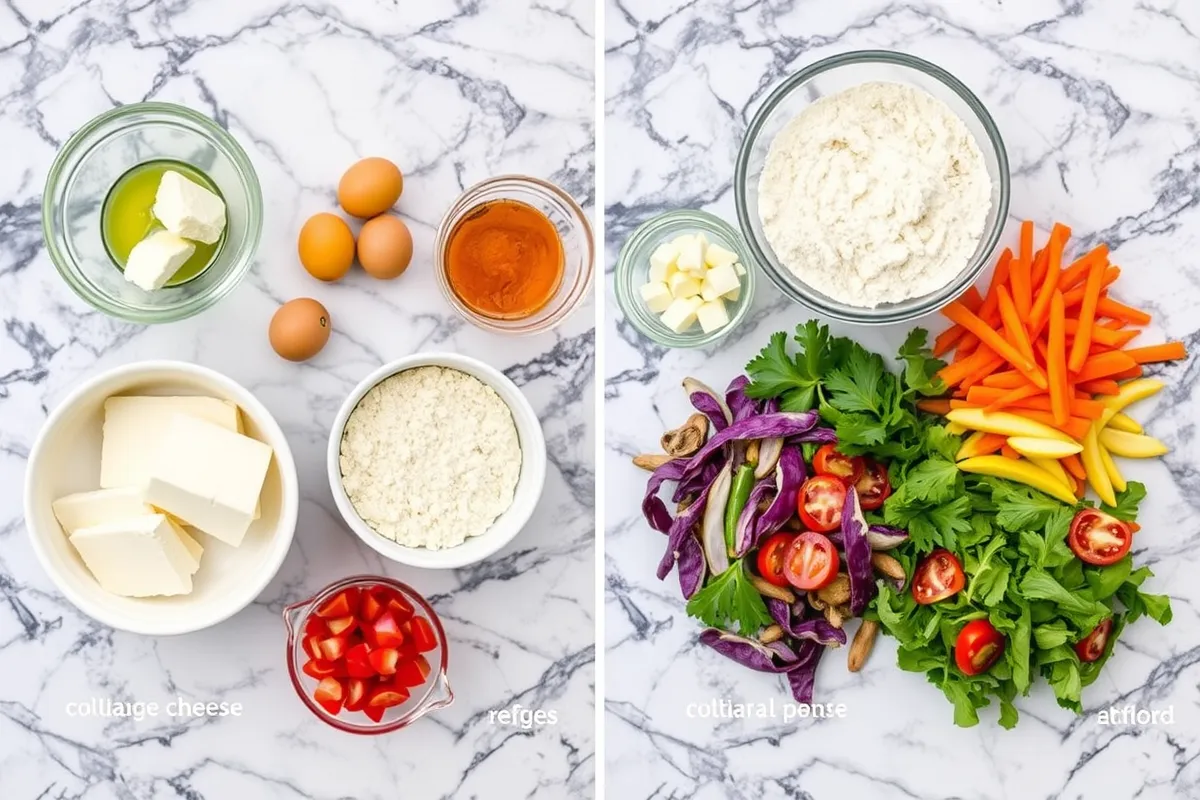Introduction
Cottage cheese flatbread pizza is revolutionizing how we think about healthy eating. With its high-protein base, low-carb benefits, and endless topping possibilities, this dish caters to a variety of dietary needs, including keto, gluten-free, and vegetarian. Whether you’re searching for a quick snack or a complete meal, this versatile pizza delivers the taste and nutrition you crave. In this guide, we’ll explore its preparation, nutritional benefits, and ways to adapt it for your specific diet. Ready to dive in? Let’s get started!
Understanding Cottage Cheese Flatbread Pizza
What Is Cottage Cheese Flatbread Pizza?
Cottage cheese flatbread pizza combines the creaminess of cottage cheese with the crispiness of a perfectly baked flatbread crust. Unlike traditional doughs that rely heavily on refined flours, this pizza uses nutrient-rich ingredients to create a healthier alternative. With its velvety texture and mild flavor, cottage cheese forms a base that’s both light and satisfying.
A Rising Trend in Healthy Eating
Recently, healthy flatbread pizza has gained popularity among health-conscious foodies, fitness enthusiasts, and families alike. It provides a guilt-free way to enjoy pizza night without sacrificing nutrition or taste. From simple Margherita styles to elaborate gourmet creations, cottage cheese flatbread pizza proves that wholesome eating can be indulgent too.
Why Choose Cottage Cheese for Your Pizza Base?
There’s more to cottage cheese than meets the eye. This high-protein dairy product is an excellent choice for those looking to cut back on carbs or add muscle-friendly nutrients to their meals. Not only does it offer a satisfying texture, but it also pairs beautifully with a range of flavors, from tangy marinara to earthy herbs and fresh veggies.
How Does It Compare to Traditional Pizza?
Traditional pizza crusts often contain excess calories and carbohydrates, making them less ideal for those managing their weight or following a specialized diet. On the other hand, cottage cheese flatbread offers a healthier solution without compromising on the essence of what makes pizza so universally beloved.
Nutritional Benefits (Cottage Cheese Flatbread Pizza)
High-Protein Content
One of the standout features of cottage cheese flatbread pizza is its protein-packed profile. Cottage cheese is renowned for its high protein content, which supports muscle repair, growth, and overall health. Unlike traditional pizza crusts that rely on carbs as their primary component, this flatbread incorporates protein-rich ingredients like eggs and almond flour.
Protein isn’t just about building muscles; it also helps to keep you feeling full longer, reducing the temptation to snack between meals. Each slice of this high-protein flatbread delivers an impressive amount of protein, making it a great post-workout meal or a satisfying lunch option. Combining the cheese’s creaminess with the flatbread’s crunch creates a harmonious balance of texture and nutrition.
Low-Carbohydrate Advantage
The low-carb nature of cottage cheese flatbread pizza makes it a popular choice for individuals following ketogenic or low-carb diets. Unlike regular pizza crusts, which can pack up to 30 grams of carbohydrates per serving, this flatbread often contains less than half that amount.
Reducing carb intake can help regulate blood sugar levels and promote weight loss, especially for those managing insulin resistance or diabetes. Additionally, swapping out refined flour for almond or coconut flour reduces glycemic impact while boosting fiber content. With fewer carbs and all the flavor, this flatbread proves you can have your pizza and eat it too.
Essential Vitamins and Minerals
Beyond protein and carbs, cottage cheese flatbread pizza is a nutrient powerhouse. Cottage cheese itself is a rich source of calcium, essential for maintaining strong bones and teeth. It also contains B vitamins like riboflavin and B12, which play a crucial role in energy production and red blood cell formation.
Using whole, fresh ingredients like vegetables and herbs as toppings further elevates the nutritional value. For instance, tomatoes provide lycopene—a powerful antioxidant—while spinach offers an iron boost. Together, these ingredients create a meal that’s as delicious as it is nourishing.
Nutritional Content of Cottage Cheese Flatbread Pizza (Per 100g)
Understanding the nutritional breakdown of cottage cheese flatbread pizza can help you make informed dietary choices. This healthy alternative offers a balanced combination of macronutrients and essential vitamins, making it a great option for any meal. Below is the approximate nutritional content per 100g serving:
| Nutrient | Amount (per 100g) | % Daily Value* |
|---|---|---|
| Calories | 160 kcal | 8% |
| Protein | 12 g | 24% |
| Fat | 8 g | 12% |
| Carbohydrates | 6 g | 2% |
| Fiber | 2 g | 8% |
| Sugar | 1 g | 1% |
| Calcium | 100 mg | 10% |
| Iron | 0.6 mg | 4% |
| Sodium | 350 mg | 15% |
This table provides insight into the high-protein, low-carb, and nutrient-rich nature of cottage cheese flatbread pizza. With fewer calories and carbs than traditional crusts, it’s an excellent choice for healthy eating.
Health Considerations for Cottage cheese flatbread pizza
Lactose Intolerance and Alternatives
Although cottage cheese flatbread pizza is a healthier choice, it’s essential to address the concerns of those who are lactose intolerant. Cottage cheese contains lactose, which can cause digestive discomfort for some individuals. Fortunately, lactose-free cottage cheese is readily available and works just as well in this recipe.
Another option is to substitute plant-based cheeses made from almond, cashew, or soy. These alternatives mimic the creamy texture of dairy without compromising taste or nutrition. With these options, even those with dietary restrictions can enjoy this wholesome dish.
Sodium Content Awareness
One potential drawback of cottage cheese is its relatively high sodium content. While sodium is essential for electrolyte balance and muscle function, excessive intake can lead to health issues like high blood pressure.
To address this, opt for low-sodium cottage cheese or rinse the cheese under cold water before use to reduce its sodium levels. Additionally, seasoning the flatbread with herbs like basil, oregano, or thyme can enhance flavor without relying on salt. These small adjustments make it easy to enjoy your pizza without overloading on sodium.
Preparation and Recipes for Cottage cheese flatbread pizza

Basic Cottage Cheese Flatbread Recipe
Making a simple cottage cheese flatbread is surprisingly easy and requires only a handful of ingredients:
- 1 cup of cottage cheese (regular or lactose-free)
- 2 large eggs
- 1 cup of almond flour
- 1 teaspoon of baking powder
- Optional: garlic powder, Italian seasoning
Instructions:
- Preheat your oven to 375°F (190°C) and line a baking sheet with parchment paper.
- In a mixing bowl, combine the cottage cheese and eggs until smooth.
- Gradually add almond flour and baking powder, mixing until a dough forms. Season as desired.
- Spread the dough onto the prepared baking sheet, shaping it into a thin, even layer.
- Bake for 15–20 minutes or until golden brown. Let it cool before adding toppings.
Cottage Cheese Flatbread Pizza Margherita
To create a classic Margherita-style pizza, you’ll need:
- Prepared cottage cheese flatbread base
- 1/2 cup of marinara sauce (sugar-free preferred)
- 1/2 cup of shredded mozzarella
- Fresh basil leaves
Instructions:
- Spread marinara sauce evenly over the flatbread.
- Sprinkle mozzarella generously, ensuring even coverage.
- Bake at 375°F (190°C) for an additional 8–10 minutes, or until the cheese is melted and bubbly.
- Garnish with fresh basil before serving.
Variations and Toppings
The beauty of cottage cheese flatbread pizza lies in its versatility. Customize it with toppings like:
- Mediterranean Style: Feta, olives, spinach, and sun-dried tomatoes.
- Veggie Supreme: Bell peppers, onions, mushrooms, and zucchini.
- Protein Packed: Grilled chicken, turkey sausage, or tofu crumbles.
Each combination adds unique flavors, ensuring that there’s always something new to try!
Dietary Suitability
Gluten-Free and Keto-Friendly Options
Cottage cheese flatbread pizza fits seamlessly into gluten-free and ketogenic diets. Traditional pizza crusts often contain wheat flour, making them unsuitable for those with gluten sensitivities or celiac disease. By using almond or coconut flour as the base, this flatbread provides a naturally gluten-free alternative that doesn’t compromise texture or flavor.
For individuals following a ketogenic diet, the low-carb flatbread is an excellent choice. Cottage cheese and almond flour are not only keto-approved but also provide healthy fats and proteins to keep you full and energized. Pairing the crust with keto-friendly toppings like mozzarella, spinach, or grilled chicken ensures the pizza aligns with your macros. Whether you’re avoiding gluten or carbs, this flatbread satisfies cravings while adhering to dietary restrictions.
Vegetarian and Vegan Considerations
Vegetarians will love this versatile dish, as it pairs perfectly with an array of fresh vegetables, herbs, and cheeses. Whether topped with tomatoes, bell peppers, or spinach, it delivers a burst of flavors that cater to plant-based diets.
For vegans, making adjustments is simple. Substitute the cottage cheese with plant-based alternatives made from cashews or tofu. Similarly, flaxseed or chia seed “eggs” can replace traditional eggs to create a vegan-friendly flatbread. Opt for non-dairy cheeses, like almond or coconut-based mozzarella, to complete the pizza. These swaps ensure everyone can enjoy this nutrient-rich dish.
Practical Tips
Storage and Shelf Life
Cottage cheese flatbread pizza is best enjoyed fresh, but proper storage allows for extended enjoyment. To store leftovers, let the flatbread cool completely before placing it in an airtight container. Refrigerate for up to three days or freeze for up to a month.
Reheating is a breeze—simply place the flatbread in an oven preheated to 350°F (175°C) for 5–8 minutes or until warmed through. Avoid microwaving, as it may affect the texture. By following these tips, you can always have a healthy, ready-to-eat meal on hand.
Serving Suggestions cottage cheese flatbread pizza
Serving cottage cheese flatbread pizza depends on the occasion. For a casual lunch, pair it with a side salad or a bowl of soup for a balanced meal. Hosting a party? Slice the flatbread into smaller pieces and serve it as an appetizer or finger food.
For family dinners, set up a topping bar where everyone can customize their pizza. Whether it’s a quiet night in or a festive gathering, this flatbread is versatile enough to suit any event. It’s the kind of dish that brings people together while catering to individual preferences.
Frequently Asked Questions (FAQs)
Can I make the flatbread without eggs?
Yes! For those avoiding eggs, substitutes like flaxseed or chia seed “eggs” work wonderfully. Simply mix one tablespoon of ground flaxseed or chia seeds with three tablespoons of water, let it sit for 5–10 minutes, and use it as a replacement.
How does the taste compare to traditional pizza crust?
While cottage cheese flatbread differs slightly from traditional crust in flavor and texture, it delivers a satisfying crunch and a rich, cheesy taste. Many find it more flavorful and filling than regular dough. Plus, its ability to hold toppings without becoming soggy makes it a hit.
What are some low-sodium cottage cheese brands?
Several brands offer low-sodium options, including Daisy, Good Culture, and Friendship Dairies. These options are great for reducing salt intake while maintaining the creamy texture and nutritional benefits of cottage cheese.

Conclusion
Embracing a Healthier Pizza Alternative
Cottage cheese flatbread pizza is more than just a meal—it’s a healthier way to enjoy a beloved classic. Packed with protein, low in carbs, and customizable for various diets, it’s the ultimate solution for guilt-free indulgence. Whether you’re gluten-free, keto, vegetarian, or vegan, this versatile dish has something for everyone.
By making simple ingredient swaps and embracing creative toppings, you can transform pizza night into a nutritious, flavor-packed experience. So, why not give this wholesome alternative a try? Your taste buds—and your body—will thank you!

